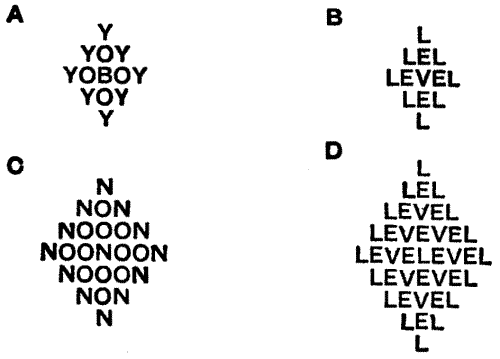The Puzzle Of The Canon's Yeoman
(
CANTERBURY PUZZLES)
This person joined the party on the road. "'God save,' quoth he, 'this jolly company! Fast have I ridden,' saith he, 'for your sake, Because I would I might you overtake, To ride among this merry company.'" Of course, he was asked to entertain the pilgrims with a puzzle, and the one he propounded was the following. He showed them the diamond-shaped arrangement of letters presented in the accompanying illustration, and said, "I do call it the rat-catcher's riddle. In how many different ways canst thou read the words, 'Was it a rat I saw?'" You may go in any direction backwards and forwards, upwards or downwards, only the successive letters in any reading must always adjoin one another.
Answer:
The number of different ways is 63,504. The general formula for such arrangements, when the number of letters in the sentence is 2n + 1, and it is a palindrome without diagonal readings, is [4(2n - 1)]2.
I think it will be well to give here a formula for the general solution of each of the four most common forms of the diamond-letter puzzle. By the word "line" I mean the complete diagonal. Thus in A, B, C, and D, the lines respectively contain 5, 5, 7, and 9 letters. A has a non-palindrome line (the word being BOY), and the general solution for such cases, where the line contains 2n + 1 letters, is 4(2n - 1). Where the line is a single palindrome, with its middle letter in the centre, as in B, the general formula is [4(2n - 1)]2. This is the form of the Rat-catcher's Puzzle, and therefore the expression that I have given above. In cases C and D we have double palindromes, but these two represent very different types. In C, where the line contains 4n-1 letters, the general expression is 4(22n-2). But D is by far the most difficult case of all.
I had better here state that in the diamonds under consideration (i.) no diagonal readings are allowed—these have to be dealt with specially in cases where they are possible and admitted; (ii.) readings may start anywhere; (iii.) readings may go backwards and forwards, using letters more than once in a single reading, but not the same letter twice in immediate succession. This last condition will be understood if the reader glances at C, where it is impossible to go forwards and backwards in a reading without repeating the first O touched—a proceeding which I have said is not allowed. In the case D it is very different, and this is what accounts for its greater difficulty. The formula for D is this:
where the number of letters in the line is 4n + 1. In the example given there are therefore 400 readings for n = 2.
See also Nos. 256, 257, and 258 in A. in M.
 Informational
Informational



